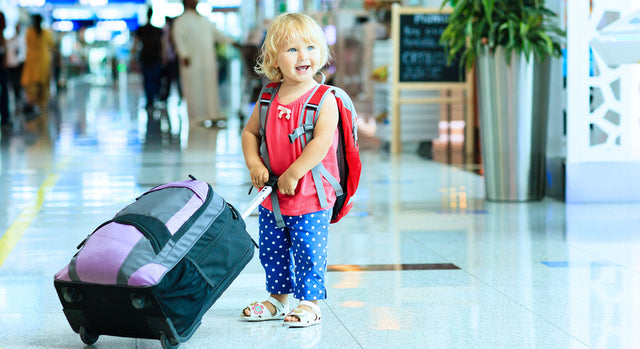How to Help Kids With Jet Lag

Whisking kids along to faraway destinations is a great way to introduce them to the world—or to see distant family and friends! The downside? Traveling with toddlers and kids can come with headaches for parents…like jet lag. So, what is the best way to prevent and handle jet lag in toddlers and kids? Here’s how to make sure jet lag doesn’t ruin your next trip!
What causes jet lag?
Essentially, jet lag is when your body’s normal rhythms are out-of-sync with a new time zone. It most often occurs when you travel across three or more time zones but can impact any new-time-zone travel. Anything that disrupts the circadian rhythm can lead to sleep problems, including traveling (especially to the east) or moving the clocks forward in the springtime for daylight saving time.
Crossing time zones to the east is tougher for us than crossing time zones traveling west. That’s because our natural circadian clock actually wants to be awake 25 to 26 hours a day. So, it’s easy for the brain to absorb an extra hour or two—but removing a few hours from our day (like when you fly from Los Angeles to New York) gives us a bad case of jet lag, which can take several days to recover from.
Tips to Prevent Jet Lag
When you travel with your toddler on short, close trips (under five days and fewer than three time zones) try to stick to your home time zone and keep your regular day schedule and bedtime routines.
But if you’re planning to travel with your toddler east across three or more time zones, gradually move your tot’s sleep and wake times a little earlier. Start a week before your trip and move things 15 minutes earlier every day or two (starting with an earlier wake-up and then shifting all naps and meals a bit earlier as well). By the time you leave, your tyke will be on (or closer to) your destination’s time zone. If traveling west, do the same thing, but move everything later in 15-minute intervals.
If you can, schedule your travel so that when you arrive, you can get settled, grab dinner, and hit the hay. Everyone is usually tired after a long flight, so this can help get your vacation off on the right foot.
Tummy aches can be a symptom of jet lag, so make sure the family eats smaller meals just before travel that are not heavy or fatty, which is harder to digest. Have kids 1 year and older drink lots of water—and avoid caffeine—before, during, and after the flight to fend off dehydration, which can worsen the symptoms of jet lag.
Poor sleep in the days before your flight can increase the likelihood of jet lag. So it’s important to prioritize quality sleep in the days leading up to travel.
How to Deal With Jet Lag in Kids
When you travel with a toddler on short, close trips (under five days and fewer than three time zones), try to stick to your home time zone and keep your regular day schedule and bedtime routines.
The key to making a good transition to a new time zone when traveling east is to get plenty of daylight and avoid sleeping too much during the day. Once you arrive, jump into the new time zone, and provide your child with lots of morning daylight and exercise to reset their brain’s melatonin release. The first day or two, wake your child if they’re sleeping more than 1 hour later than their normal waking time. For little ones, move naptime earlier if they’re very tired during the day. For big kids and teens who normally don’t nap, it’s okay to allow them to cat nap for 15 to 20 minutes if they’re super sleepy. This is enough to refresh them, but not enough to wreak havoc on their nighttime sleep.
Adjust your eating schedule to your new time zone using healthy snacks to fill in the gaps. If your child wakes up in the middle of the night starving, it’s okay to offer a bland snack, like a banana or a cheese stick, with the lights dimmed, of course!
It can be tricky to settle down to sleep in an unfamiliar location at a strange time, so offer your child familiar sleepytime cues and bedtime routines. Familiarity breeds comfort and sleep! That means, travel with cherished items like a favorite bedtime book, their familiar white noise machine, a comforting lovey, even their own familiar sheets!